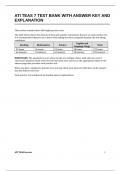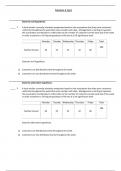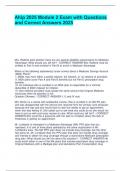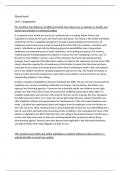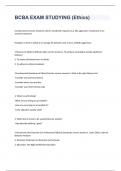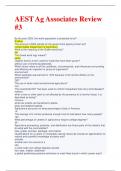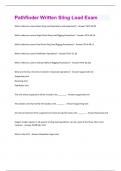Summary - Business Level Strategy
This summary covers the following papers in detail:
1. Nadkarni, S., Chen, T. and Chen, J. 2016. The clock is ticking! Executive
temporal depth, industry velocity, and competitive aggressiveness. Strategic
Management Journal, 37(6): 1132-1153
2. Boyd, J. L. and Bresser, R. K. 2008. Performance implications of delayed
competitive responses: evidence from the U.S. retail industry. Strategic
Management Journal, 29: 1077-1096
3. Eisenhardt, K.M. and Martin, J.A. (2000), Dynamic capabilities: what are they?
Strategic Management Journal, 21: 1105-1121
4. Schilke, O. 2014. On the contingent value of dynamic capabilities for
competitive advantage: The nonlinear moderating effect of environmental
dynamism, Strategic Management Journal 35 (2), 179-203
5. Flammer C. 2013. Corporate Social Responsibility and Shareholder Reaction:
The Environmental Awareness of Investors, Academy of Management Journal,
56(3): 758-781
6. Hawn, O. and Ioannou, I. 2016. Mind the gap: The interplay between external
and internal actions in the case of corporate social responsibility. Strategic
Management Journal, 37
7. Hatch, N.W. and Dyer, J.H. (2004), Human capital and learning as a source of
sustainable competitive advantage. Strategic Management Journal, 25: 1155-
1178
8. Riley, S. M., Michael, S. C. and Mahoney, J. T. 2017. Human capital matters:
Market valuation of firm investments in training and the role of complementary
assets. Strategic Management Journal, 38: 1895-191
9. Cassiman and Veugelers 2006. In Search of Complementarity in Innovation
Strategy: Internal R&D and External Knowledge Acquisition. Management
Science, 52 (1)
10. Klingebiel, R. and Joseph, J. (2016), Entry timing and innovation strategy in
feature phones. Strategic Management Journal, 37: 1002-1020
,Article 1. The Clock is ticking! Executive Temporal Depth, Industry
Velocity, and Competitive Aggressiveness
Main concept: (executive) temporal depth
= Time frame on which you base your decisions
(Not mentioned in the article, but the relationship between industry velocity and
temporal depth also goes the other way around: the industry velocity can and will
influence the manager’s temporal depth too)
Temporal depth can be checked by looking at what people are writing (in reports, etc.).
By looking at the choice of words and more.
Implication of the article:
• Choose a person that is comfortable with the speed of things that are happening
within an industry. People are naturally more long or short term in terms of
temporal depth. Match people with industry velocity.
Theories used in the article:
• Upper echelons perspective
• This research emphasizes that executive orientations create filters in
how they notice and interpret competitive cues and in turn determine a
firm’s overall propensity to initiate new and responsive actions (Chen and
Miller, 2012). Top managers are influencing decisions of the firm.
• The article brings together a lot of different theories: economic, psychological,
micro/macro-levels → it is a very rich theoretical paper
Limitation of the measures:
• It could be better on the psychological measure, but it is probably not
realistic/possible to achieve this data collection.
• Rich theory requests a lot of different data sources → very hard project
,Introduction
The market is viewed as a disequilibrium system:
• Competitive dynamics research rests on the premise that changing conditions
render a firm’s positioning in a competitive market temporary either in the short
run or the long run.
In this article, the interplay is examined between:
• Temporal depth
• Industry velocity
• Competitive aggressiveness
Temporal depth
= Timer horizons that executives consider when contemplating past and future events.
Industry velocity
= The rate at which new opportunities emerge and disappear in an industry.
Competitive aggressiveness
= A firm’s propensity to challenge rivals directly and intensely to maintain or improve
its market position.
(The degree to which a firm engages intensely with its rivals through its competitive
repertoires, which are a set of market actions (e.g., price changes) used by the firm in
a given year to proactively get ahead of rivals and to respond to rival’s actions.)
High degree: “the firm has rapidly taken a large number of actions.”
The article identifies two sets of temporal forces moving the creation and erosion of
competitive advantage:
• Macro temporal forces (Industry-level)
• Micro temporal forces (Firm-level)
Macro temporal forces
= Defines the time windows of opportunities available for incumbents to establish new
advantages and reduce the advantages of competitors and impose different levels of
pressure on incumbents to retaliate.
Micro temporal forces
= Actions taken by individual firms. These forces determine a firm’s competitive
advantage over competitors and in turn their survival success.
Firms that take speedy and frequent competitive actions are better positioned
competitively and have, as a result of that, superior performance.
, One of the gaps addressed is the limited understanding of ‘how executives’ temporal
orientations shape competitive behaviors.
• Executive orientations create filters in how they notice and interpret competitive
cues and in turn determine a firm’s overall propensity to initiate new and
responsive actions.
• The perspective of time is temporal. Temporal orientations mold expectations
and evaluations of situations and form the basis of executives’ strategic choices.
Studies have shown that temporal heuristics and preferences used by managers in
sequencing and pacing activities are for critical for capturing:
• Capturing new opportunities
• Becoming informed of external environment changes
• Adjusting firm strategies to this change
The article suggests that ‘’Temporal orientations’’ are likely to serve as a third force in
determining the competitive behavior of a firm.
Note that ‘’Temporal orientation’’ is in the article captured under the term ‘’Temporal
depth’’ thus, temporal orientation:
= Timer horizons that executives consider when contemplating past and future events.
… Or the temporal distance into the past and the future that executives typically
consider when contemplating events that have happened or may happen.
Time horizons are important aspects of a firm’s strategic orientation.
• Short time horizons provide flexibility and quick adaption, but also give rise to
temporal myopia (myopia = bijziendheid) and economic short-termism.
• Long time horizons lend foresight in management but delay short-term
adaptation to changing environmental conditions.
Considerations of which time horizon to maintain has implications for strategic choices.
The paper suggests that the relationship between executive temporal depth,
competitive behaviors, and firm performance will be moderated by industry velocity.
• Industry velocity = (see definition above)
• Industry velocity sets the competitive clock for incumbent firms to act and
react.
Competitive behaviors is conceptualized as competitive aggressiveness; a
fundamental concept of capturing interfirm rivalry (see definition above).
This summary covers the following papers in detail:
1. Nadkarni, S., Chen, T. and Chen, J. 2016. The clock is ticking! Executive
temporal depth, industry velocity, and competitive aggressiveness. Strategic
Management Journal, 37(6): 1132-1153
2. Boyd, J. L. and Bresser, R. K. 2008. Performance implications of delayed
competitive responses: evidence from the U.S. retail industry. Strategic
Management Journal, 29: 1077-1096
3. Eisenhardt, K.M. and Martin, J.A. (2000), Dynamic capabilities: what are they?
Strategic Management Journal, 21: 1105-1121
4. Schilke, O. 2014. On the contingent value of dynamic capabilities for
competitive advantage: The nonlinear moderating effect of environmental
dynamism, Strategic Management Journal 35 (2), 179-203
5. Flammer C. 2013. Corporate Social Responsibility and Shareholder Reaction:
The Environmental Awareness of Investors, Academy of Management Journal,
56(3): 758-781
6. Hawn, O. and Ioannou, I. 2016. Mind the gap: The interplay between external
and internal actions in the case of corporate social responsibility. Strategic
Management Journal, 37
7. Hatch, N.W. and Dyer, J.H. (2004), Human capital and learning as a source of
sustainable competitive advantage. Strategic Management Journal, 25: 1155-
1178
8. Riley, S. M., Michael, S. C. and Mahoney, J. T. 2017. Human capital matters:
Market valuation of firm investments in training and the role of complementary
assets. Strategic Management Journal, 38: 1895-191
9. Cassiman and Veugelers 2006. In Search of Complementarity in Innovation
Strategy: Internal R&D and External Knowledge Acquisition. Management
Science, 52 (1)
10. Klingebiel, R. and Joseph, J. (2016), Entry timing and innovation strategy in
feature phones. Strategic Management Journal, 37: 1002-1020
,Article 1. The Clock is ticking! Executive Temporal Depth, Industry
Velocity, and Competitive Aggressiveness
Main concept: (executive) temporal depth
= Time frame on which you base your decisions
(Not mentioned in the article, but the relationship between industry velocity and
temporal depth also goes the other way around: the industry velocity can and will
influence the manager’s temporal depth too)
Temporal depth can be checked by looking at what people are writing (in reports, etc.).
By looking at the choice of words and more.
Implication of the article:
• Choose a person that is comfortable with the speed of things that are happening
within an industry. People are naturally more long or short term in terms of
temporal depth. Match people with industry velocity.
Theories used in the article:
• Upper echelons perspective
• This research emphasizes that executive orientations create filters in
how they notice and interpret competitive cues and in turn determine a
firm’s overall propensity to initiate new and responsive actions (Chen and
Miller, 2012). Top managers are influencing decisions of the firm.
• The article brings together a lot of different theories: economic, psychological,
micro/macro-levels → it is a very rich theoretical paper
Limitation of the measures:
• It could be better on the psychological measure, but it is probably not
realistic/possible to achieve this data collection.
• Rich theory requests a lot of different data sources → very hard project
,Introduction
The market is viewed as a disequilibrium system:
• Competitive dynamics research rests on the premise that changing conditions
render a firm’s positioning in a competitive market temporary either in the short
run or the long run.
In this article, the interplay is examined between:
• Temporal depth
• Industry velocity
• Competitive aggressiveness
Temporal depth
= Timer horizons that executives consider when contemplating past and future events.
Industry velocity
= The rate at which new opportunities emerge and disappear in an industry.
Competitive aggressiveness
= A firm’s propensity to challenge rivals directly and intensely to maintain or improve
its market position.
(The degree to which a firm engages intensely with its rivals through its competitive
repertoires, which are a set of market actions (e.g., price changes) used by the firm in
a given year to proactively get ahead of rivals and to respond to rival’s actions.)
High degree: “the firm has rapidly taken a large number of actions.”
The article identifies two sets of temporal forces moving the creation and erosion of
competitive advantage:
• Macro temporal forces (Industry-level)
• Micro temporal forces (Firm-level)
Macro temporal forces
= Defines the time windows of opportunities available for incumbents to establish new
advantages and reduce the advantages of competitors and impose different levels of
pressure on incumbents to retaliate.
Micro temporal forces
= Actions taken by individual firms. These forces determine a firm’s competitive
advantage over competitors and in turn their survival success.
Firms that take speedy and frequent competitive actions are better positioned
competitively and have, as a result of that, superior performance.
, One of the gaps addressed is the limited understanding of ‘how executives’ temporal
orientations shape competitive behaviors.
• Executive orientations create filters in how they notice and interpret competitive
cues and in turn determine a firm’s overall propensity to initiate new and
responsive actions.
• The perspective of time is temporal. Temporal orientations mold expectations
and evaluations of situations and form the basis of executives’ strategic choices.
Studies have shown that temporal heuristics and preferences used by managers in
sequencing and pacing activities are for critical for capturing:
• Capturing new opportunities
• Becoming informed of external environment changes
• Adjusting firm strategies to this change
The article suggests that ‘’Temporal orientations’’ are likely to serve as a third force in
determining the competitive behavior of a firm.
Note that ‘’Temporal orientation’’ is in the article captured under the term ‘’Temporal
depth’’ thus, temporal orientation:
= Timer horizons that executives consider when contemplating past and future events.
… Or the temporal distance into the past and the future that executives typically
consider when contemplating events that have happened or may happen.
Time horizons are important aspects of a firm’s strategic orientation.
• Short time horizons provide flexibility and quick adaption, but also give rise to
temporal myopia (myopia = bijziendheid) and economic short-termism.
• Long time horizons lend foresight in management but delay short-term
adaptation to changing environmental conditions.
Considerations of which time horizon to maintain has implications for strategic choices.
The paper suggests that the relationship between executive temporal depth,
competitive behaviors, and firm performance will be moderated by industry velocity.
• Industry velocity = (see definition above)
• Industry velocity sets the competitive clock for incumbent firms to act and
react.
Competitive behaviors is conceptualized as competitive aggressiveness; a
fundamental concept of capturing interfirm rivalry (see definition above).


